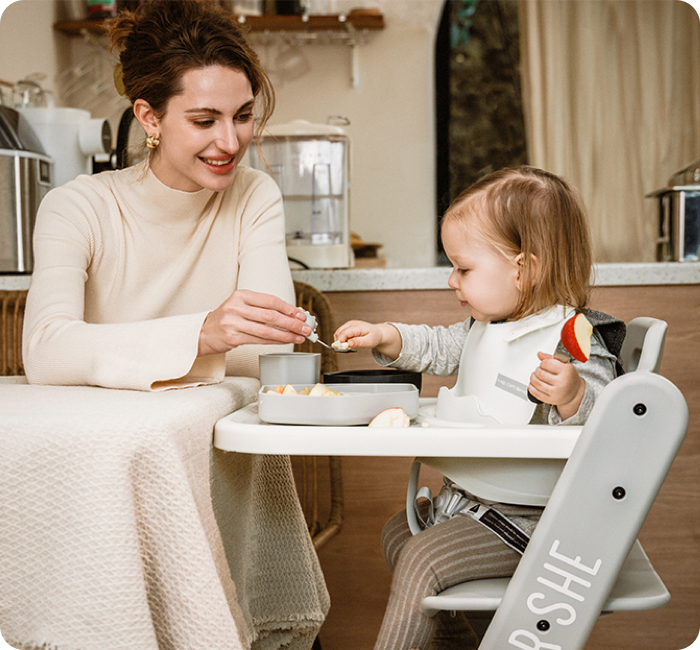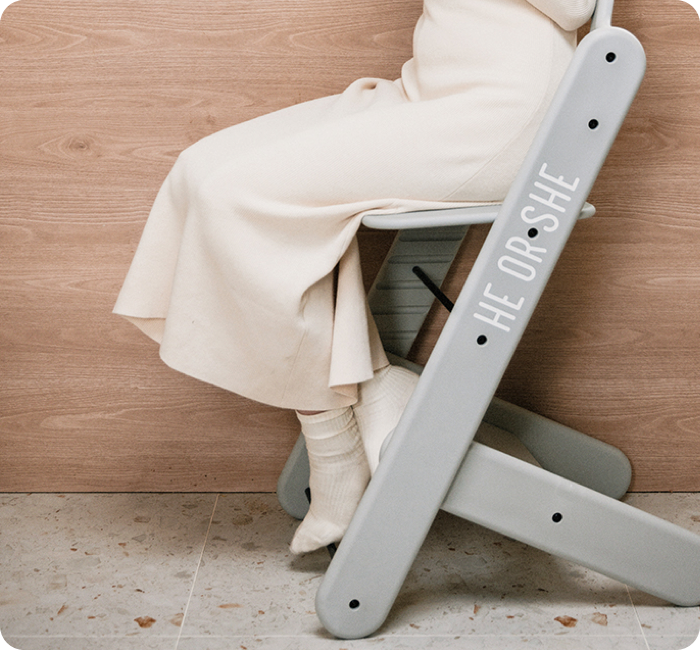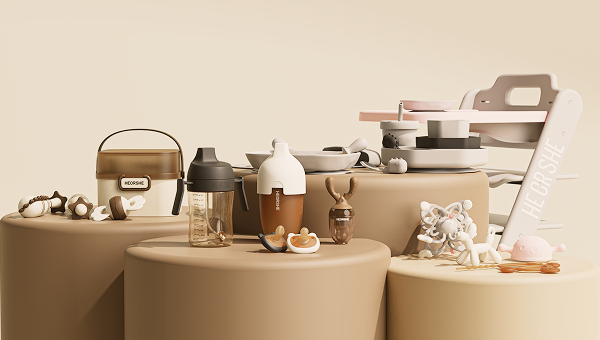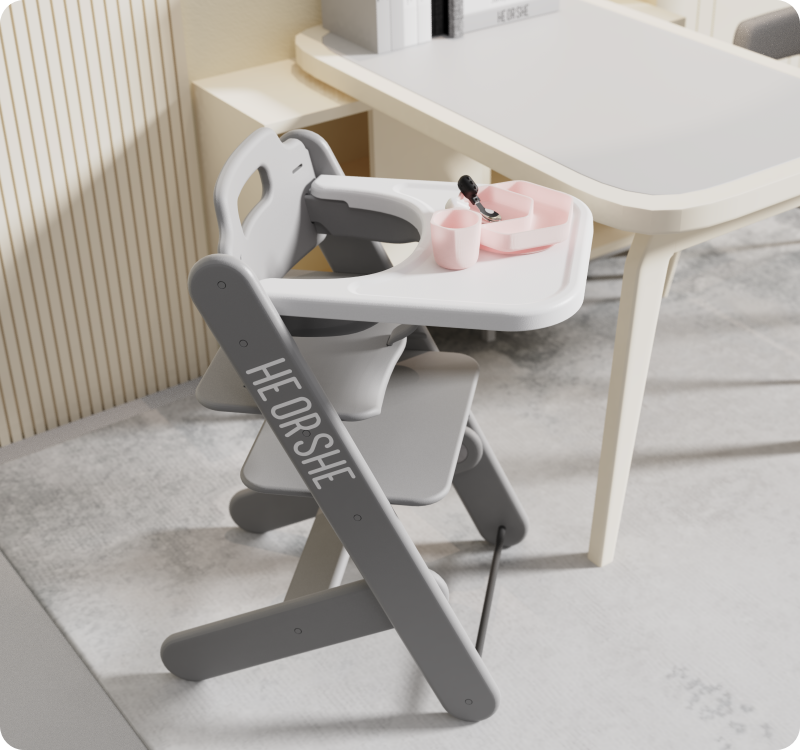Why Choosing the Right Baby Feeding Chair Matters?
Feeding your baby is an essential part of their development, and the experience should be both comfortable and safe for the parent and the child. The right infant feeding chair not only makes feeding easier but also supports your baby’s posture, keeps them secure, and even aids in their social and cognitive development as they start joining family meals.
In today’s market, there are many types of baby feeding chairs available, each with its unique features and benefits. From compact chairs perfect for small spaces to high-end models with a full range of adjustments, it can be overwhelming for parents to decide which chair is best for their baby. This blog aims to help you navigate through the options and choose the best infant high chair for your child.
What is an Infant Feeding Chair?
An infant feeding chair, commonly known as a high chair, is a specialized piece of furniture designed to facilitate feeding infants and toddlers. These chairs are engineered with several key features to make mealtime more convenient and secure for both parents and children. A typical high chair includes a secure seat, a high backrest for support, and a tray for holding food and drinks. This setup helps ensure that the baby is in an upright and comfortable position, making feeding easier and safer.
Baby feeding chairs come in a variety of designs and functionalities, tailored to accommodate different stages of a child's development and diverse feeding needs. Many high chairs offer multiple reclining positions, allowing for adjustments as the baby grows or as their needs change. Adjustable height settings ensure that the chair can be positioned at the right level for different tables or feeding areas, enhancing convenience for parents. Safety harnesses are an essential feature, providing secure restraint to keep the baby safely in place during meals.
The best infant high chairs combine these features to offer a versatile and practical solution for feeding. As technology and design continue to evolve, modern high chairs are also incorporating additional features such as easy-to-clean surfaces, foldable designs for storage, and even conversion options that allow the chair to grow with the child, making them a valuable investment for any family.

Key Features to Look for in the Best Infant High Chair
When selecting a baby feeding chair, several key features contribute to its safety, practicality, and durability:
Safety Features are paramount in a high chair. A 5-point or 3-point harness system is crucial for keeping your baby securely seated during meals. The 5-point harness offers superior safety by securing the baby at the shoulders, waist, and between the legs, preventing them from sliding or standing up. Additionally, a stable base is essential to prevent tipping over, particularly as your baby becomes more active and may wiggle or lean. The chair should have a wide and sturdy base to ensure it remains upright during use.
Comfort is also an important consideration. An adjustable recline feature is beneficial for younger babies who are not yet able to sit up independently, allowing the chair to be adjusted to a comfortable angle. A padded seat ensures that your baby remains comfortable during mealtimes, making feeding more enjoyable for both the baby and the parent.
Ease of Cleaning is crucial for maintaining hygiene. A detachable tray that is dishwasher-safe simplifies the cleaning process after meals. Additionally, wipeable surfaces made of materials like vinyl or plastic are easier to clean than fabric, reducing the effort required to keep the chair sanitary.
Adjustability enhances the chair’s longevity and functionality. Height adjustments allow the chair to be used at various table heights and adapt as your baby grows. An adjustable footrest provides support for your child, promoting comfort and proper posture.
Portability features add convenience. A foldable design is ideal for families with limited space, allowing the chair to be stored compactly. Some models also include wheels with locks for easy mobility and positioning, making it simpler to move the chair around the home.
Types of Baby Feeding Chairs
There are several distinct styles of baby feeding chairs, each tailored to different needs and preferences, providing various benefits depending on your situation:
Traditional High Chair: This classic design is what many people envision when they think of a baby high chair. Traditional high chairs are freestanding and tall, featuring a tray for holding food and drinks. They often come with adjustable recline positions, making them suitable for babies who can sit up unassisted. These chairs provide a dedicated feeding area and are generally sturdy and stable, ensuring safety during mealtimes.
Convertible High Chair: A convertible high chair offers exceptional versatility. It can transform from an infant feeding chair into a toddler seat and, in some models, even into a regular chair for older children. This adaptability makes convertible high chairs a valuable long-term investment, as they can grow with your child and accommodate different stages of their development. This type of chair is ideal for families looking for a multifunctional solution that extends beyond the infant years.
Booster Seat: Booster seats are designed to attach to regular dining chairs, allowing your baby to join the family at the dining table. They are more compact and portable compared to traditional high chairs, making them a practical choice for older babies and toddlers. Booster seats are easy to move and store, offering flexibility and convenience while helping your child become accustomed to dining at the family table.
Hook-On Chair: A hook-on chair attaches directly to the edge of a dining table, providing a space-saving solution for families with limited room. These chairs are lightweight and portable, making them suitable for travel or small living spaces. However, they are generally recommended for babies who can sit up on their own, as they may not provide the same level of support for younger infants. Hook-on chairs are perfect for parents seeking a compact, travel-friendly option.

Benefits of Using a Baby Feeding Chair
Using a baby feeding chair offers numerous advantages that extend beyond mere convenience, enhancing both safety and developmental benefits:
Safety: A well-designed infant feeding chair prioritizes your baby's security during mealtimes. Features like a secure harness system and a stable base help prevent accidents such as choking or falling. By keeping your baby firmly seated, the chair significantly reduces the risk of unexpected movements that could lead to injury.
Support: High chairs are engineered to provide essential back and neck support, which is crucial for infants who are still developing their sitting skills. Proper support helps maintain good posture and comfort while your baby learns to sit upright, contributing to their overall physical development.
Independence: Feeding chairs encourage self-feeding, a critical milestone in a baby's development. By allowing your child to sit at the table and reach for their food, the high chair promotes hand-eye coordination and fine motor skills. This sense of independence fosters confidence and helps your baby develop essential eating skills.
Easy Clean-Up: Most modern feeding chairs are designed with practicality in mind, featuring wipeable materials and removable trays. These design elements simplify the clean-up process after meals, reducing the time and effort required to maintain a hygienic feeding area. The ease of cleaning helps keep the feeding environment sanitary and stress-free for parents.
Best Infant High Chair for Small Spaces
For those living in small apartments or with limited kitchen space, selecting an infant high chair that maximizes functionality while minimizing space usage is essential. Here are some key features to look for:
- Compact Design: Opt for high chairs with a smaller footprint that can fit comfortably in tight spaces. These models are designed to take up less room without compromising on safety or comfort. Their streamlined design ensures they don’t overwhelm your kitchen or dining area.
- Foldability: Choose high chairs that can fold flat for easy storage when not in use. Foldable models are particularly advantageous in small spaces, allowing you to stow the chair away neatly and reclaim your floor area after mealtime.
- Multi-functionality: Consider high chairs that offer additional features beyond just feeding. Some models can convert into toddler chairs or play chairs, providing versatility and reducing the need for multiple pieces of furniture. This multifunctional approach helps you maximize the use of your space and makes the most of your investment.
For an even more space-efficient option, you might explore booster seats or hook-on chairs. Booster seats attach to your existing dining chairs, while hook-on chairs attach directly to the edge of a table, both of which can be excellent solutions for small living areas.
How to Choose the Best Infant Feeding Chair for Your Baby
When selecting the best infant feeding chair, several factors should be considered to ensure you make the most suitable choice for your family’s needs:
- Age and Stage of Your Baby: Different stages of infancy and toddlerhood require different features. For newborns and younger infants, a high chair with a recline feature is important to provide comfort and support during feedings. As your baby grows and can sit upright, transitioning to a more upright position is ideal. Convertible high chairs offer the advantage of adapting to various stages, starting from infancy and extending through toddlerhood, making them a long-term investment.
- Space Considerations: Assess your dining area to ensure that the high chair fits comfortably without cluttering the space. Measure your available area and consider the chair's footprint to avoid overcrowding your kitchen or dining room. For those in smaller homes or apartments, portable or foldable options are highly recommended. These models can be easily stored away when not in use, helping to maintain an organized and spacious environment.
- Ease of Use: Opt for a chair that is straightforward to adjust, clean, and maneuver. Features such as an easily removable tray and wipeable surfaces will simplify cleanup, while adjustable settings allow the chair to grow with your baby. Ensure that the chair is user-friendly to make feeding times smoother for both you and your baby.
- Budget: High chairs vary widely in price, from basic models to high-end designs with additional features. Determine which features are essential for your needs and which ones you can forego to stay within your budget. A well-chosen high chair will provide good value, balancing cost with necessary functionality and durability.
Safety Considerations for Infant Feeding Chairs
When selecting an infant feeding chair, safety should always come first. Here are key safety features to ensure your baby stays secure during mealtime:
- Stable Base: A wide, stable base is critical for preventing the chair from tipping over, especially as your baby becomes more active. A sturdy foundation adds balance, ensuring the chair remains firmly in place during use.
- Harness: A 5-point harness is ideal for keeping your baby securely fastened in the chair. This type of harness secures your baby at five points—across the shoulders, waist, and between the legs—minimizing the risk of slipping, sliding, or standing up during feeding.
- Locking Wheels: If your high chair includes wheels for mobility, ensure that they have a locking mechanism to prevent unintended movement. Locked wheels provide stability during feeding sessions, keeping the chair stationary and safe.
- No Sharp Edges: The chair should have smooth, rounded edges to avoid injuries. Additionally, check for small parts that could pose a choking hazard, especially if your baby has a tendency to explore their surroundings by touching and mouthing objects.
How to Properly Clean and Maintain a Baby Feeding Chair
Regular cleaning and maintenance of your baby feeding chair are crucial for maintaining hygiene and ensuring the chair’s longevity. Here are some tips to keep it in top condition:
Cleaning Tips:
- Tray: Detachable trays should be wiped down after every meal to prevent the buildup of food residue. Many trays are dishwasher-safe, making thorough cleaning quick and easy. If not, a simple wash with warm soapy water will suffice.
- Seat and Harness: Always refer to the manufacturer’s guidelines for cleaning the seat and harness. Some high chair seats are machine washable, while others may need to be hand-wiped with a damp cloth. The harness, if detachable, should be cleaned regularly to remove any food particles or spills.
Regular Inspections:
- Check for wear and tear: Periodically inspect the chair for loose screws, worn-out straps, or any signs of damage. A worn harness or loose hardware could compromise the safety of the chair.
- Maintain functionality: Ensure that all adjustable parts, such as reclining mechanisms or height adjustments, are functioning smoothly. Any broken or malfunctioning components should be repaired or replaced immediately.
Conclusion
Choosing the right infant feeding chair is an important decision that involves considering your baby’s age, your available space, and your budget. Babies who are just starting solids may need a high chair with adjustable recline features, while older infants may benefit from a more upright design. For smaller homes or apartments, compact and foldable chairs, such as booster seats or hook-on models, offer a space-saving solution without sacrificing functionality. Each type of chair has its advantages, so it’s important to assess which one best meets your needs based on how and where you plan to feed your baby.
When selecting a feeding chair, prioritize safety, ease of cleaning, and adjustability. Look for chairs with a 5-point harness, stable bases, and materials that are easy to wipe down after meals. Some high chairs come with dishwasher-safe trays and machine-washable seat covers, which can simplify cleanup. Adjustability is another key feature to consider, as a high chair that grows with your child can offer long-term value. Whether you’re in need of a traditional high chair, a wall-mounted baby feeding chair, or a portable booster seat, this guide aims to help you make an informed decision that ensures both comfort and safety during mealtime for your little one.



